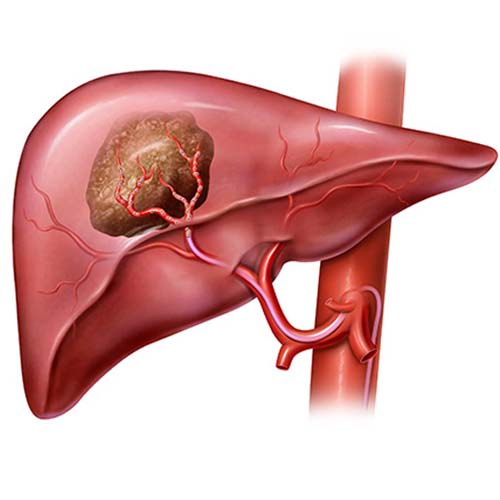Radiation embolization treatment in Türkiye
Radiation embolization or better known as intra-arterial precision radiotherapy is a minimally invasive procedure that combines embolization with radiotherapy. For the treatment of liver cancer , treatment is based in essence on the placement of small beads of glass or resin “ resin beads ”. Filled with the isotope yttrium Y-90 inside blood vessels. Which feeds the tumor, which blocks the blood supply of cancer cells and delivers a high dose of radiation to the tumor. While it preserves normal tissues and thus helps to extend the life of patients with inoperable tumors and improve their quality of life.

What is radiation embolism?
Embolization: This is a minimally invasive treatment in which blood vessels or abnormalities within the blood vessels are blocked to prevent blood flow.
Internal radiation therapy: It is the use of a specific type of energy, called ionizing radiation, to kill cancer cells and shrink tumors. It involves placing radioactive material directly into the body, unlike external beam radiation therapy (EBT).
Radiation embolization: It is the insertion of small glass or resin beads called microspheres. Inside the blood vessels that feed the tumor in order to prevent blood from getting to the cancer cells. A high dose of radiation is sent directly to the tumor and not to the normal tissue, once it has settled at the tumor site.
What are some common uses for this procedure?
Radiation embolization is used to treat tumors that initially formed in the liver or spread to the liver from another part of the body. This treatment falls under the category of palliative treatments, meaning that it does not provide a cure but instead helps slow the growth of the disease and relieve symptoms. It is an option for patients who are not candidates for other treatments such as surgery or a liver transplant.
How to prepare for the procedure:
A number of medical examinations and consultations must be done before the procedure, such as a blood test to determine how well the kidneys are working and whether the blood is clotting normally. In addition to imaging the blood vessels that feed the tumor before surgery, the doctor in charge of the case must be informed of all medications that the patient is taking, including herbal supplements, and he must stop taking aspirin, non-steroidal anti-inflammatory drugs (NSAIDs) or blood thinners before the procedure. Women should also inform the doctor if there is pregnancy or the possibility of pregnancy in order to take appropriate precautions.
What equipment is used during the radiation embolization procedure?
This procedure uses X-ray equipment, catheters and microspheres, or small glass beads filled with the radioactive isotope yttrium-90. and an ultrasound machine, and devices that monitor your heartbeat and blood pressure.
Radiation embolization overview:
First it uses X-ray imaging and contrast material to visualize the blood vessels. Then the interventional radiologist inserts a catheter through the skin into a blood vessel and guides it to the treatment site. After that, the microspheres filled with radiation are inserted through the catheter and transferred to the blood vessels that supply the tumor with blood through the hepatic artery. The microspheres then emit a high dose of radiation directly to the cancer cells at the site of the tumor, once they settle there, in addition to blocking the blood flow to the tumor. This deprives diseased cells of the oxygen and nutrients needed for growth. The radiation emitted by yttrium-90 decreases steadily over two weeks and disappears after 30 days.
Note: There are two primary blood vessels that carry blood to the liver, the portal vein and the hepatic artery and its branches. Normal liver tissue receives about 75 percent of its blood supply through the portal vein and about 25 percent from the hepatic artery and its branches, so the tumor receives (almost) in the liver when it grows. All blood supply is from the hepatic artery, so because the radioactive microspheres are delivered through the hepatic artery, they reach the tumor very directly while sparing most of the healthy liver tissue.
How is the operation performed?
Image-guided minimally invasive procedures (such as radiation embolization) are performed by an interventional radiologist. Specially trained in the interventional radiology suite, first arterioles are performed to depict the upper abdominal arteries, the arteries leading to the stomach and duodenum are closed, and a pill containing a nuclear medicine tracer is injected at the end of the procedure through the catheter to simulate treatment, allowing the interventional radiologist to calculate the amount of treatment dose that can be To go to the lungs so that lung damage does not occur.
As for the steps of the operation, first the patient is placed on his back. It connects to monitors that track heart rate , blood pressure, oxygen level, and pulse. And a nurse or technician inserts an intravenous (IV) tube into the vein of the hand or arm to give the sedative. The area where the catheter will be inserted is sterilized and covered with a surgical gown. Once the catheter reaches the branches of the hepatic artery that feeds the tumor, small glass granules or microscopic pellets are injected through the catheter. Finally, the catheter is removed when the procedure is completed, and the wound is closed.
Radiation embolism risks:
Like any other procedure, there is a risk of infection and there is a very small risk of an allergic reaction if contrast material is injected. Some risks associated with inserting a catheter into a blood vessel include damage to the blood vessels, bruising or bleeding at the puncture site, and infection. There is a 2% risk that the microbeads settle in the wrong place, putting the patient at risk of developing a stomach or duodenal ulcer.
What are the therapeutic limits of radiation embolization?
Radiation embolization treatment is not recommended in cases of severe impairment of liver or kidney function, abnormal blood clotting, or obstruction of the bile ducts. Approximately 70 to 95 percent of patients have a liver improvement and survival rates improve depending on the type of liver cancer with multiple studies showing benefit in up to 95 percent of patients with colorectal metastases (metastases) and up to 97 percent of patients present with neuroendocrine tumours.
How can I book for radiation embolization treatment in Türkiye?

- Free medical support on the phone: You will have a dedicated representative for your health condition who is always ready to answer your questions.
- Free consultation with a specialist doctor: Your medical representative will consult with a number of doctors and hospitals to find the best possible treatments.
- Free travel visa arrangement: We will contact the embassy in your country to assist you in obtaining a visa to visit Türkiye.
- Free itinerary planning: We will create a schedule for your medical trip to Türkiye.
- Free translation of documents and reports: We will translate medical documents and reports into Turkish on your behalf.
- Free support and monitoring: We will monitor the stages of treatment and be by your side every step of the way.
- Free instant translation: We will be with you during the treatment stages to provide translation between you and the medical team.
- Free accommodation and transportation coordination: We will book accommodation for you and your companions in Türkiye, along with transportation services.
Contact REHABTÜRK doctors for more information about the procedure and to evaluate your medical condition.
